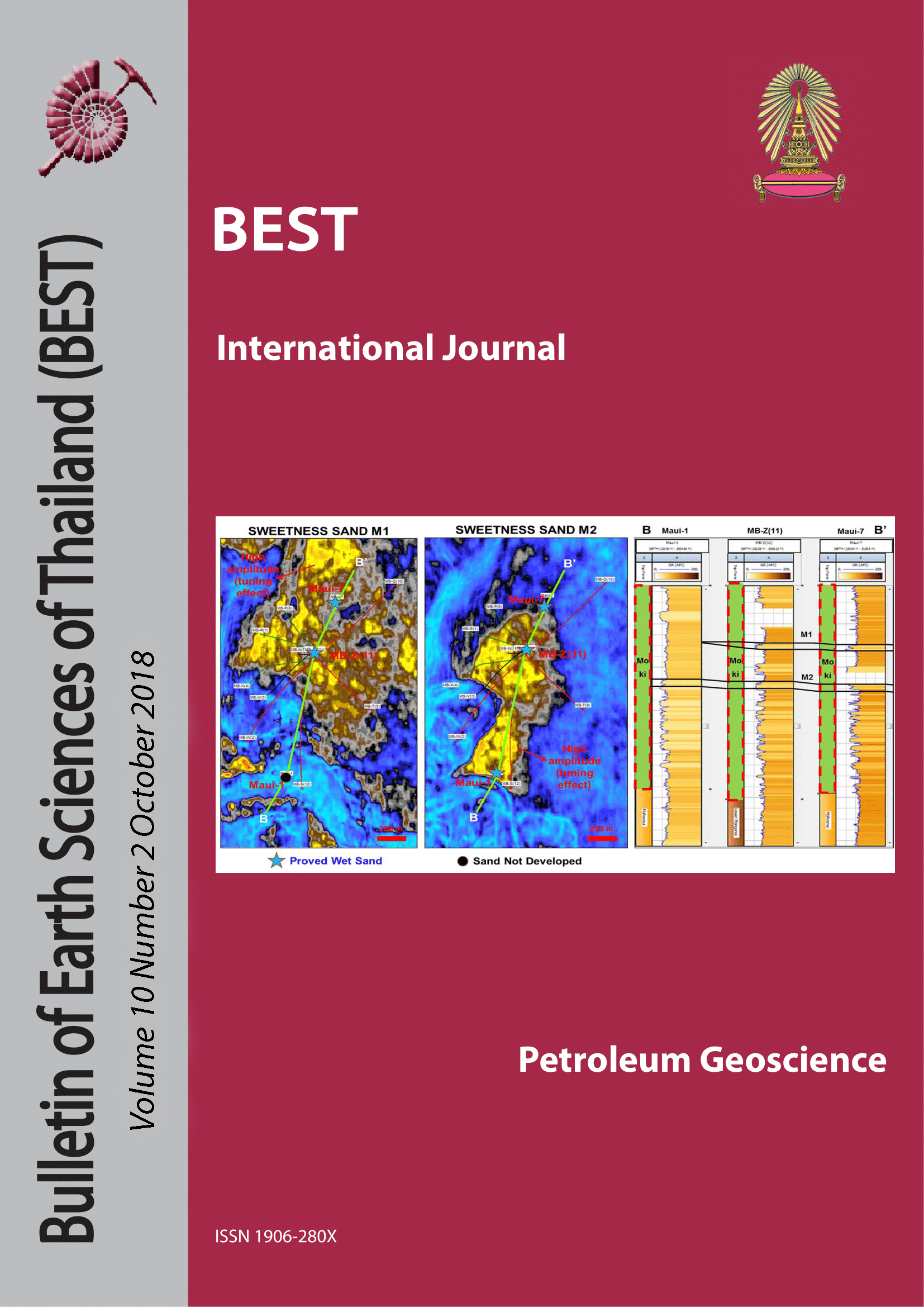Integrating Wireline Interpretation with Rock Properties to Better Determine Controls on the Occurrence of Reservoir Sand in Pohokura Field, Taranaki Basin, New Zealand
Main Article Content
Abstract
This study of reservoir sands in two wells in the Eocene Mangahewa Formation Pohokura Field, New Zealand is designed to show how integrating field-scale information from FMI interpretation with existing core and rock property data helps in gaining a better understanding the reservoirs sands. Specifically, it aims to quantify controls on the behav- ior of the reservoir’s porosity and permeability. In the Pohokura-1 well, lamination and cross lamination dips are pre-dominantly SE and NW and subparallel to Pohokura anticlinal structure. In contrast, dips of lamination in the Pohokura South-1 well show more polymodal trends. These differences in lamination trend indicate differences in sand body orientation, which under petrographic study translates to the sand bodies in each well experiencing different depositional or tectonic histories. There are different sources of sediment supply and hence rock type due to different paleocurrent directions (as indicated by differences in cross lamination directions). Depositional environ-ments, (not diagenesis) play a fundamental role in determining reservoir quality as they control the character of the original pore network in the newly deposited sediments. Massive Sandstone lithofacies (as defined in FMI) is seen to form the best quality reser- voir where muddy lamination and bioturbation are seen to be detrimental to the reservoir quality. Overall, each of the documented diagenetic factors shows a damaging effect on the reservoir quality, but grain size and sorting dominate. Subsequent compaction and cementation are more critical post depositional effects compared to authigenic clay content and grain dissolution. There is a positive relationship between porosity-permeability and total quartz cement (levels <6% quartz overgrowth) as it sets up a stable grain framework that resists compaction. Beyond 6%, higher amounts of quartz overgrowth cement are detrimental as the cement is now present in sufficient pore volumes to occlude pore throats and lower permeability. In conclusion, differences in sand body geometry and probably different sources of sediment supply, together with textural, compositional and diagenetic variations between wells result in differences in reservoir quality. Pohokura-1 has a relatively better reservoir quality than Pohokura South-1 as the reservoir sand is coarser grained, and more quartzose dominant. In contrast, reservoir sands in Pohokura South-1 are finer-grained and more diagenetically active due to inherently higher feldspar and lithic contents.
Article Details

This work is licensed under a Creative Commons Attribution-NonCommercial-NoDerivatives 4.0 International License.
Copyright © 2008 Department of Geology, Faculty of Science, Chulalongkorn University. Parts of an article can be photocopied or reproduced without prior written permission from the author(s), but due acknowledgments should be stated or cited accordingly.
References
Crown Minerals, 2001, New Zealand Potential - 2: Numerous play types evident in Taranaki basin, Inversion Structures, Volume 2018, Oil&Gas Journal. https://www.ogj.com/ articles/print/volume-99/issue-30/explorationdevelopment/new-zealand-potential-2numerous-play-types-evident-in-taranakibasin.html
King, P. R.; Thrasher, G. P. 1996: CretaceousCenozoic geology and petroleum systems of the Taranaki Basin, New Zealand. Institute of Geological & Nuclear Sciences Monograph 13. Lower Hutt, Institute of Geological & Nuclear Sciences Ltd. 243 p., 6 encl.
King, P.R., Thrasher, G.P., 1992. Post Eocene development of the Taranaki Basin, New Zealand: convergent overprint of a passive margin. In: Watkins, J.S., Zhiqiang, F., McMillen, K.J. (Eds.), Geology and Geophysics of Continental Margins, vol. 53. American Association of Petroleum Geologists Memoir, pp. 93-118.
Sykes, R., Volk, H., George, S. C., Ahmed, M., Higgs, K. E., Johansen, P. E., and Snowdon, L. R., 2014, Marine influence helps preserve the oil potential of coaly source rocks: Eocene Mangahewa Formation, Taranaki Basin, New Zealand: Organic Geochemistry, v. 66, p. 140-163.
Core Laboratories, 2000a, Pohokura-1 Core Analysis Report and Core Photographs (August 2000): NZPAM Online Exploration Database.
Core Laboratories, 2001, Pohokura South-1 Core Analysis Report and Core Photographs: NZPAM Online Exploration Database.
Higgs, K. E./Fletcher Challenge Energy Taranaki; 2001; A Petrographic and Reservoir Quality Study of Well Pohokura South-1. Ministry of Economic Development New Zealand Unpublished Petroleum Report PR2650.


